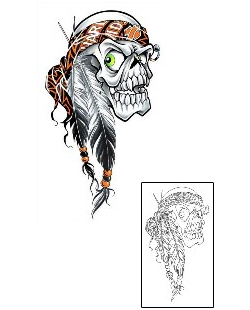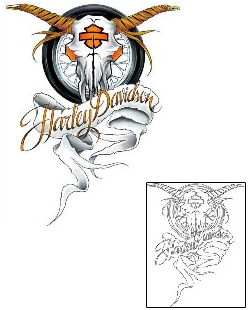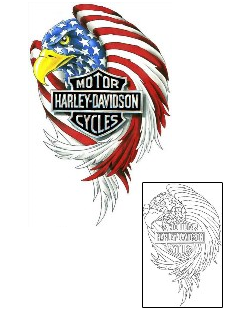Tattoos have been a major part of biker culture for decades. Ever since rebels started riding the road, popular biker tattoos like Live to Ride, Ride to Live and various gang tattoos that indicated fellowship, brotherhood and sometimes threats of physical violence have been deeply integrated into biker culture and associated with motorcycles and motorcycle aficionados since the dawn of the motorcycle. Due to Harley Davidson's iconic popularity, clever marketing strategies and proudly aggressively American heritage (the company is based in Milwaukee, Wisconsin), the Harley Davidson emblem has taken on a life and a meaning of its own outside of the people who buy and ride the bikes.
Harley Davidson tattoos are somewhat unique as far as biker tattoos go because while they are definitely the realm of Harley Davidson enthusiasts, they are by no means restricted to those who own and ride Harley Davidson bikes. Harley Davidson tattoos often indicate a goal, such as owning a Harley, which can also indicate an individual's desire for a certain degree of security and affluence or the ambition to own one's own business or achieve other goals that will ultimately lead to the purchase of the Harley itself. Harley Davidson tattoos also often express an appreciation for the lifestyle adopted by Harley riders, which tends to be one of freedom and the open road at least on the weekends. To many people, Harley Davidson tattoos have come to symbolize biking itself as well as an affection for the company that makes the bikes or the bikes themselves. However, Harley Davidson's are generally acknowledged to be the ultimate in motorcycle riding and ownership, so there is a general endorsement associated with a Harley Davidson tattoo.
There are many different types of Harley Davidson tattoos. Generally, the Harley Davidson tattoo integrates the Harley Davidson emblem of a shield with the Harley Davidson logo emblazoned on it. Sometimes, people just get the shield itself, with the trademark white, black and orange color scheme. This is very popular in locations like the back of the neck or the small of the back, where the tattoo will be easily visible if the owner wishes to expose it, but it can be covered up for work during the week. This is likely the most discreet version of the Harley Davidson tattoo. Black and gray Harley Davidson tattoos are also very popular because they look slightly more hardcore and can be made to appear metallic and three-dimensional. These grayscale tattoos are often startlingly realistic! They are popular not only because they are Harley Davidson tattoos, but also because they are more unusual than many other forms of Harley Davidson tattoos, but still express unity with other Harley aficionados and affection for motorcycle riding and the biker lifestyle in general.
Many people who really love Harley Davidson and biking get much more elaborate Harley Davidson tattoos. These tattoos usually still integrate the Harley Davidson shield, but the accompanying designs are much more elaborate. Patriotic tattoos easily incorporate the Harley logo to become patriotic Harley Davidson tattoos, and classic biker tattoos often do the same. Often Harley riders have friends who have either died in combat overseas or who used to ride with them but either died of illness or even in vehicle crashes. As a result, many Harley Davidson tattoos evolve into memorial tattoos as the tattoo owner ages, and often people with Harley Davidson tattoos incorporate birth and death dates into the Harley Davidson theme along with images like swallow tattoos, pinup tattoos and a variety of roses and skulls to create a beautiful memorial art piece based around the Harley Davidson shield and the people who shared the tattoo owner's affection for the brand and the lifestyle.
Whether you want a Harley Davidson tattoo because you live to ride and ride to live, or because you have always admired other people's Harley Davidson tattoos and want one of your own, getting a Harley Davidson tattoo will place you in a fellowship with other motorcycle riders and aficionados. Whenever people see your tattoo, they will assume certain things about you, so be aware of the ramifications of your Harley Davidson tattoo and place and design it carefully so that you will enjoy it for the rest of your life.










